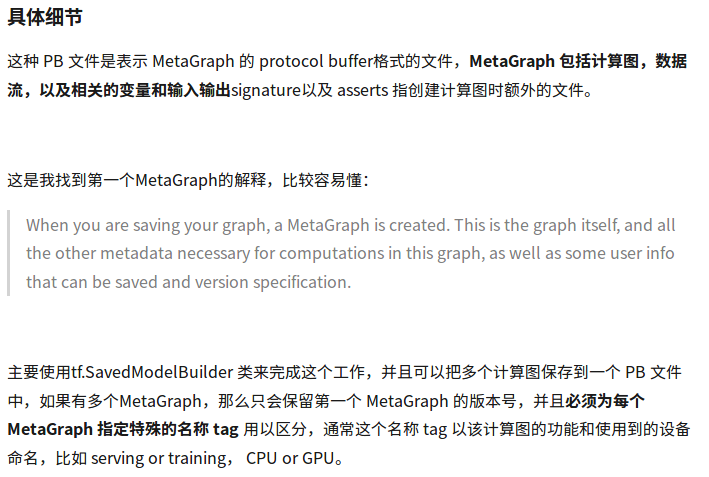tensorflow儲存資料為.pb格式和載入pb檔案
阿新 • • 發佈:2019-01-05
最近接觸了tensorflow的object detection API發現裡面讀取的預先訓練模型都是pb格式。
谷歌推薦的儲存模型的方式是儲存模型為 PB 檔案,它具有語言獨立性,可獨立執行,封閉的序列化格式,任何語言都可以解析它,它允許其他語言和深度學習框架讀取、繼續訓練和遷移 TensorFlow 的模型。
它的主要使用場景是實現建立模型與使用模型的解耦, 使得前向推導 inference的程式碼統一。
另外的好處是儲存為 PB 檔案時候,模型的變數都會變成固定的,導致模型的大小會大大減小,適合在手機端執行。
還有一個就是,真正離線測試使用的時候,pb格式的資料能夠保證資料不會更新變動,就是不會進行反饋調節啦。
儲存 PB 檔案的程式碼:
import tensorflow as tf
import os
from tensorflow.python.framework import graph_util
pb_file_path = os.getcwd()
with tf.Session(graph=tf.Graph()) as sess:
x = tf.placeholder(tf.int32, name='x')
y = tf.placeholder(tf.int32, name='y')
b = tf.Variable(1, name='b')
xy = tf 載入 PB 模型檔案典型程式碼:
from tensorflow.python.platform import gfile
sess = tf.Session()
with gfile.FastGFile(pb_file_path+'model.pb', 'rb') as f:
graph_def = tf.GraphDef()
graph_def.ParseFromString(f.read())
sess.graph.as_default()
tf.import_graph_def(graph_def, name='') # 匯入計算圖
# 需要有一個初始化的過程
sess.run(tf.global_variables_initializer())
# 需要先復原變數
print(sess.run('b:0'))
# 1
# 輸入
input_x = sess.graph.get_tensor_by_name('x:0')
input_y = sess.graph.get_tensor_by_name('y:0')
op = sess.graph.get_tensor_by_name('op_to_store:0')
ret = sess.run(op, feed_dict={input_x: 5, input_y: 5})
print(ret)
# 輸出 26
儲存為 save model 格式也可以生成模型的 PB 檔案,並且更加簡單。
儲存好以後到saved_model_dir目錄下,會有一個saved_model.pb檔案以及variables資料夾。顧名思義,variables儲存所有變數,saved_model.pb用於儲存模型結構等資訊。
import tensorflow as tf
import os
from tensorflow.python.framework import graph_util
pb_file_path = os.getcwd()
with tf.Session(graph=tf.Graph()) as sess:
x = tf.placeholder(tf.int32, name='x')
y = tf.placeholder(tf.int32, name='y')
b = tf.Variable(1, name='b')
xy = tf.multiply(x, y)
# 這裡的輸出需要加上name屬性
op = tf.add(xy, b, name='op_to_store')
sess.run(tf.global_variables_initializer())
# convert_variables_to_constants 需要指定output_node_names,list(),可以多個
constant_graph = graph_util.convert_variables_to_constants(sess, sess.graph_def, ['op_to_store'])
# 測試 OP
feed_dict = {x: 10, y: 3}
print(sess.run(op, feed_dict))
# 寫入序列化的 PB 檔案
with tf.gfile.FastGFile(pb_file_path+'model.pb', mode='wb') as f:
f.write(constant_graph.SerializeToString())
# INFO:tensorflow:Froze 1 variables.
# Converted 1 variables to const ops.
# 31
# 官網有誤,寫成了 saved_model_builder
builder = tf.saved_model.builder.SavedModelBuilder(pb_file_path+'savemodel')
# 構造模型儲存的內容,指定要儲存的 session,特定的 tag,
# 輸入輸出資訊字典,額外的資訊
builder.add_meta_graph_and_variables(sess,
['cpu_server_1'])
# 新增第二個 MetaGraphDef
#with tf.Session(graph=tf.Graph()) as sess:
# ...
# builder.add_meta_graph([tag_constants.SERVING])
#...
builder.save() # 儲存 PB 模型
這種方法對應的匯入模型的方法:
with tf.Session(graph=tf.Graph()) as sess:
tf.saved_model.loader.load(sess, ['cpu_1'], pb_file_path+'savemodel')
sess.run(tf.global_variables_initializer())
input_x = sess.graph.get_tensor_by_name('x:0')
input_y = sess.graph.get_tensor_by_name('y:0')
op = sess.graph.get_tensor_by_name('op_to_store:0')
ret = sess.run(op, feed_dict={input_x: 5, input_y: 5})
print(ret)
# 只需要指定要恢復模型的 session,模型的 tag,模型的儲存路徑即可,使用起來更加簡單
這樣和之前的匯入 PB 模型一樣,也是要知道tensor的name。那麼如何可以在不知道tensor name的情況下使用呢,實現徹底的解耦呢? 給add_meta_graph_and_variables方法傳入第三個引數,signature_def_map即可。
參考:
https://zhuanlan.zhihu.com/p/32887066

